Nothing is hotter in the gardening world right now than succulents. The ease of care combined with the seemingly endless interesting varieties of plants have made succulents popular with novice and experienced gardeners.
Red succulents are a great way to add depth and color to your home or garden. Here are six red succulents that every gardener needs to know.
1. Romeo Echeveria (Echeveria agavoides Romeo)
The echeveria is a wildly popular rosette succulent. The many cultivars (1,000+) of echeveria provide unlimited display options for your home or garden.
The Echeveria agavoides variety resembles a small agave plant. Agavoides means “resembling agave.”
There are numerous cultivars and varieties of this echeveria succulent, several of which are red, like the Romeo plant. This succulent showcases deep, dark red hues on its glossy, fleshy leaves. This particular echeveria mutation was created in Germany.
Like most echeveria succulents, the Romeo needs lots of sun with only occasional watering. This particular variety is rated for Zones 9-12 on the USDA plant hardiness scale.
Other red echeverias include the “Maria,” “Margaret Martin,” “lipstick” (also known as “red edge”), “Frank Reinelt,” and “rajoya.”
Echeveria plants are classified as non-toxic for pets.
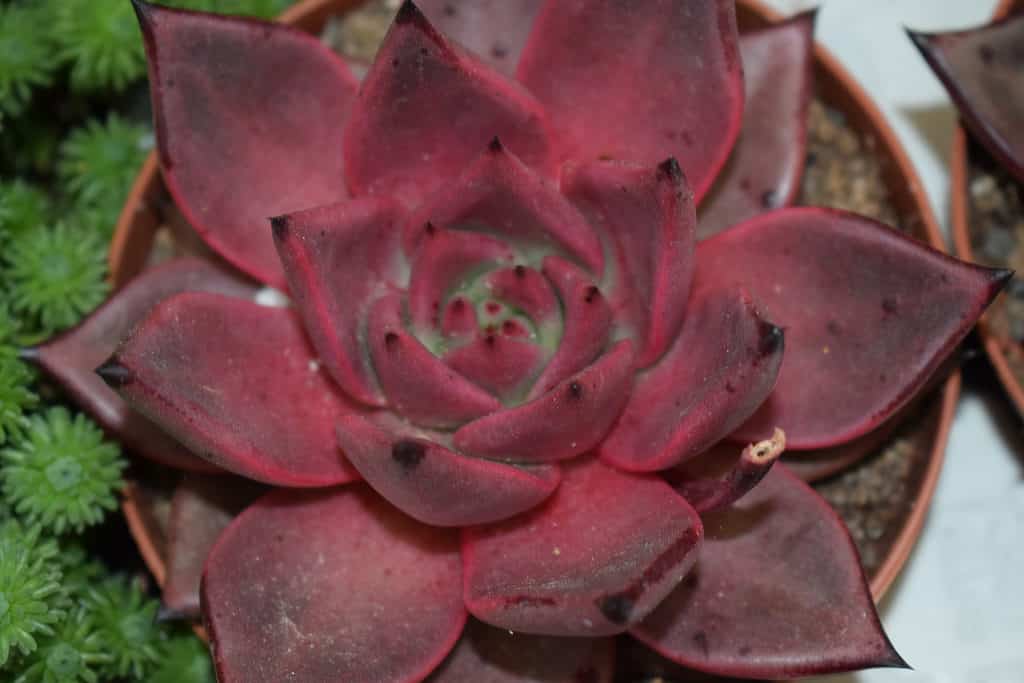
The Romeo echeveria features dark, wine-red leaves.
©Furiarossa/Shutterstock.com
2. Christmas Carol Aloe (Aloe’ Christmas Carol’)
This festive succulent features the colors of Christmas with dark green fleshy leaves accented with bright red trim. When provided with ample sun, the raised spots on the leaves can turn to shades of crimson, painting the entire plant a lovely holiday red.
This aloe cultivar features leaves that are more triangular than those of the aloe vera plant. When viewed from above, the leaves form a star shape, further adding to its Christmasy vibe. But this aloe plant isn’t relegated to December. It delights gardeners all year long.
The Christmas carol aloe is rated for Zones 9b-11, where it can thrive in settings such as decorative rock gardens. If you reside in a cooler zone, the Christmas carol aloe is an ideal houseplant as long as it receives ample sunlight. If you don’t have a spot in your home where it can bask in the sun for 4-5 hours a day, you can use a grow light as a supplement. Without adequate light, this aloe plant will never display the deep red colors that many growers love.
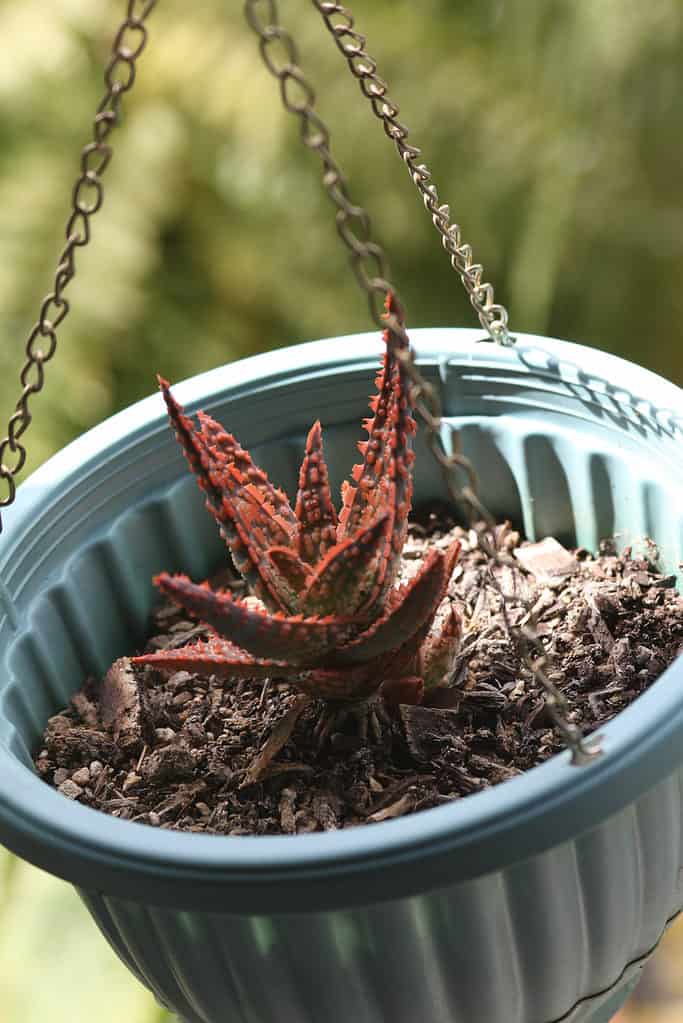
The Christmas carol aloe has festive green leaves accented with red trim and spots.
©Ashleigh Tomasetig/Shutterstock.com
3. Flapjack Plant (Kalanchoe luciae)
Also known as “paddle plants,” flapjack plants are herbaceous succulents with a rather unique look. The leaves seem to stack one on top of another, similar in appearance to a stack of pancakes.
This succulent is native to South Africa and thrives in sunny, dry conditions. That’s why they are only recommended for outdoor growing in Zones 10-12.
Ample sun is critical to bring out the gorgeous red hues on the leaves. When the plant is in shaded or cooler conditions, the leaves will retain their mostly green color, with only slight tinges of red. But the leaves will transition to gorgeous shades of red when the plant is “happily stressed” with sunshine for at least six hours a day. Bringing the brightest reds out of the leaves can be tricky when growing indoors. It’s difficult to give the plant the amount of sunshine needed to coax the full green-to-red transformation.
As long as the temperature doesn’t drop below 60°F, you can take your flapjacks outside during the summer, where they can bask in the sun. That’s when the red will really pop. Just remember that this is not a cold-hardy plant at all. You may want to bring it inside at night, even during the summer.
All parts of the flapjack plant are toxic to humans and pets.
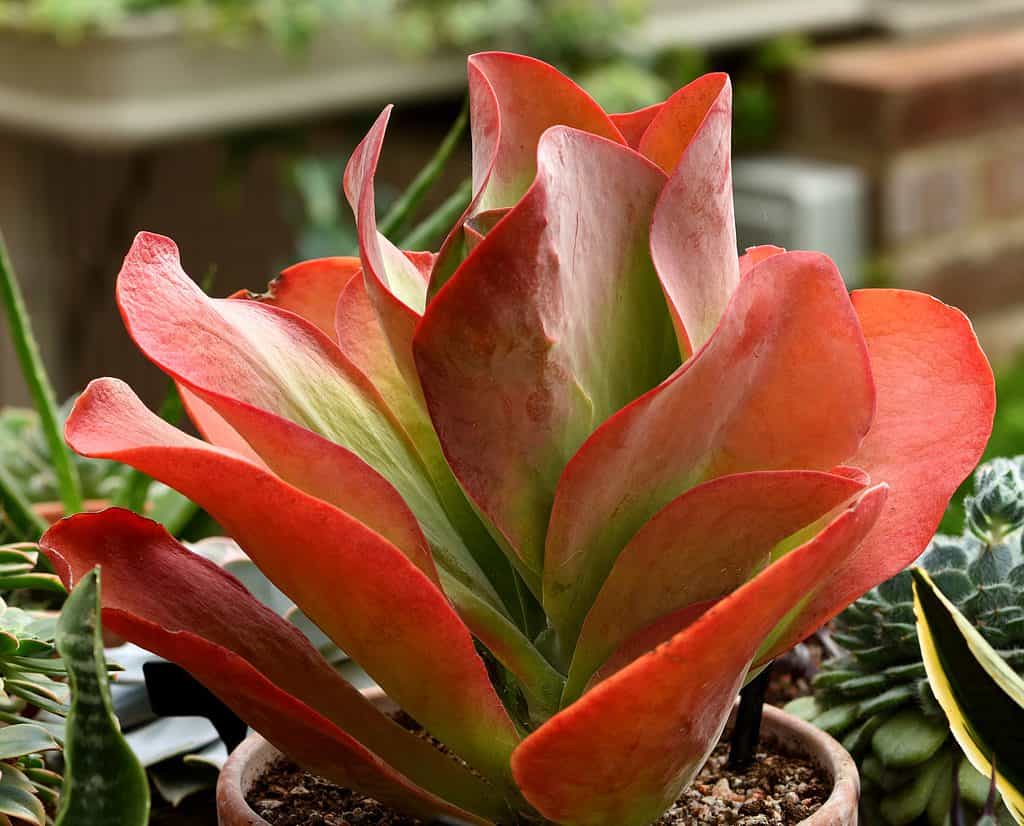
With adequate sunlight, the leaves of the flapjack plant turn from green to a beautiful red.
©iStock.com/MichelR45
4. Pencil Cactus (Euphorbia tirucalli)
Despite its common name, the pencil cactus is not a true cactus. Rather, it is part of the euphorbia family of succulents native to tropical and subtropical regions of Africa and Madagascar.
The plant has some other common name,s too, including “sticks of fire,” referring to the brilliant shades of red the plant displays in the right conditions.
Six hours of sunlight a day is a good rule of thumb for this succulent (as well as most other succulent plants). Like the flapjack plant, the sun is the only thing that will coax out the brilliant red hues that give this plant its fiery reputation.
This succulent has little frost tolerance and is recommended for Growing Zones 10a-11b. Most growers use containers that can sit in the sun on warm days but also be moved inside during colder weather.
Extra caution is required whenever you handle this succulent. The milky white fluid (latex) that seeps out when a stem is cut is highly toxic. In fact, some indigenous peoples in this succulent’s native Africa use the latex from the plant to poison their arrows and spears. Gardeners have even been hospitalized due to the effects of the latex. In addition, if the fluid makes contact with the eyes, it can cause temporary blindness.
Given the level of toxicity, make sure to wear gloves and eye protection when handling this plant. Households with young children should avoid the pencil cactus.
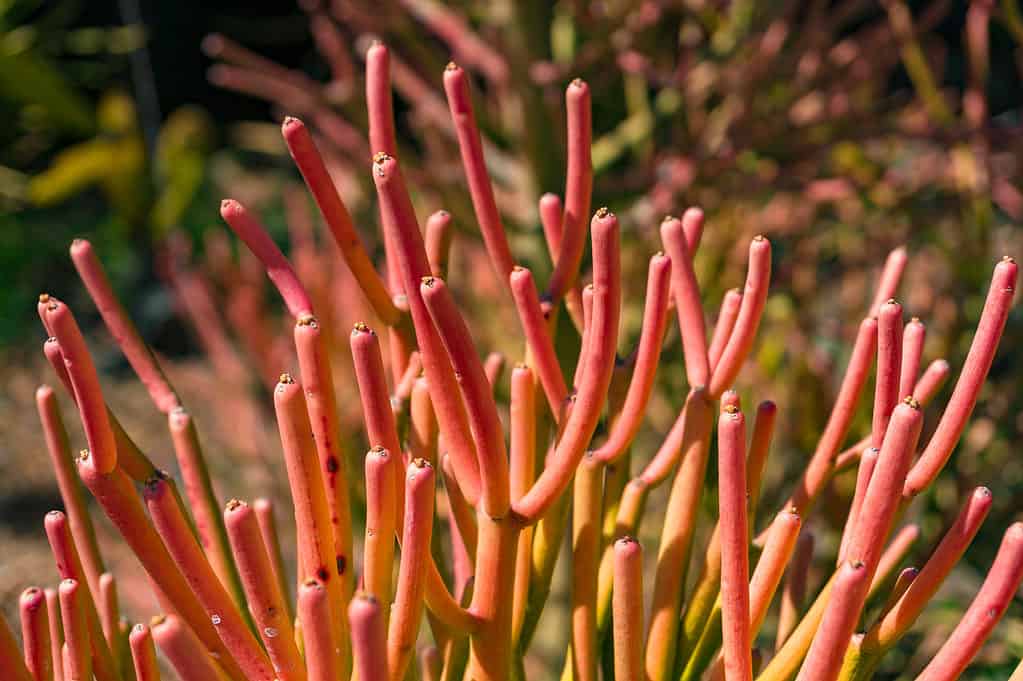
The pencil cactus is also known as “sticks of fire” because of its fiery orange-red appearance.
©Olga Kashubin/Shutterstock.com
5. Red Aloe (Aloe cameronii)
This is another lesser-known variety of aloe. But, while aloe vera might get all the attention, the red aloe is one of the most beautiful aloe plants on the market.
Its showy fleshy leaves range in color from a typical aloe green to a deep wine red. Like many other red succulents, the deepest, most brilliant red hues will only display when the plant is stressed (in a good, friendly, happy way). The red hues will pop if the plant receives full sun and conditions are dry. However, the leaves will remain green if they sit in the shade or are overwatered.
This is probably not an aloe plant for the windowsill. The red aloe reaches heights of two feet, with a four-foot spread. It is recommended for outdoor gardens in Zones 9a-11b.
The red aloe plant is non-toxic. In fact, it can be used to treat minor skin irritations and burn,s just like its more famous relative, aloe vera. But, given the relative rarity of this succulent, most gardeners opt for some other form of treatment if they happen to get a little sunburned.
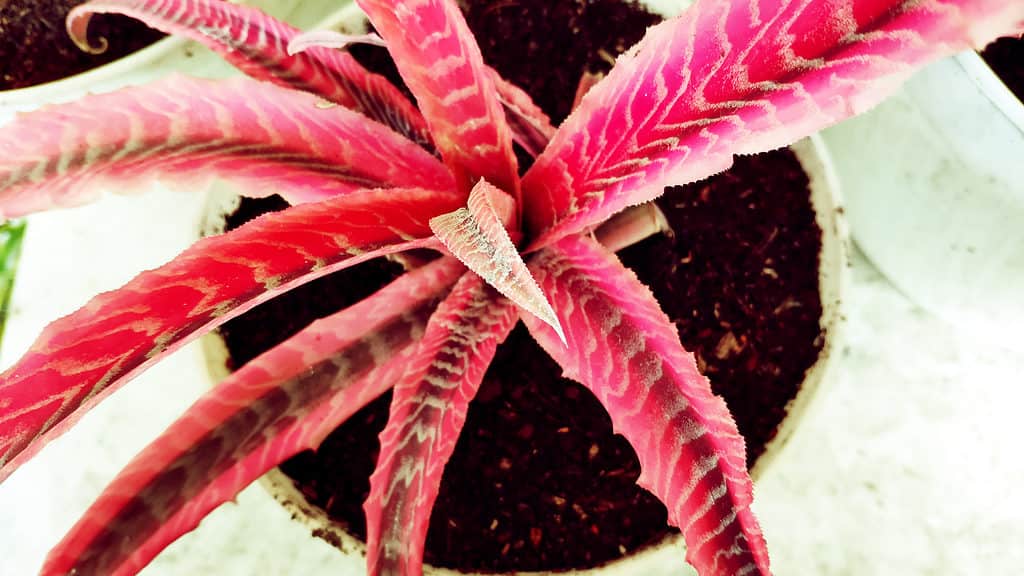
The red aloe displays deep hues of red when stressed.
©wira farashi. st/Shutterstock.com
6. Red Wiggle (Sedum ochroleucum’ Red Wiggle’)
This perennial is a fun little succulent plant. It grows no higher than 3-4 inches but can spread over a foot wide. This plant makes an excellent drought-tolerant ground cover. It is also more cold-hardy than many succulents, recommended for outdoor growing in Zones 4-9.
The leaves are shaped like needles, similar to those of an evergreen tree. It looks like a miniature evergreen forest when these succulents cover the ground. And don’t be surprised if butterflies invade your mini forests. They love these little plants! These succulents are also deer and rabbit resistant, which is music to a gardener’s ears.
Red wiggles thrive in gravelly, well-draining soil. As a result, they require almost no watering except in exceptional drought conditions.
The leaves are green when the plant is young, but then change to a lovely red as the succulent matures, making it a bi-color beauty. Finally, the whole plant turns to a brilliant red in late fall and winter.
Sedums, such as the red wiggle, are classified as non-toxic.
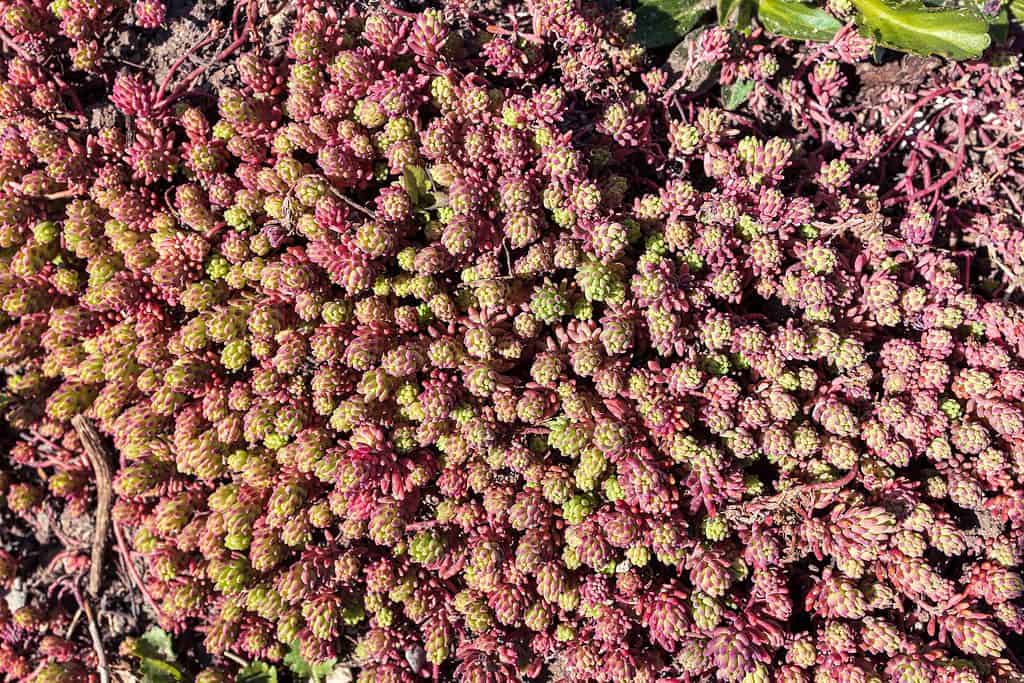
When grown together as ground cover, red wiggle plants form a mini-forest right there in your garden.
©Elena Rostunova/Shutterstock.com
The photo featured at the top of this post is © T. Schneider/Shutterstock.com
Thank you for reading! Have some feedback for us? Contact the AZ Animals editorial team.






